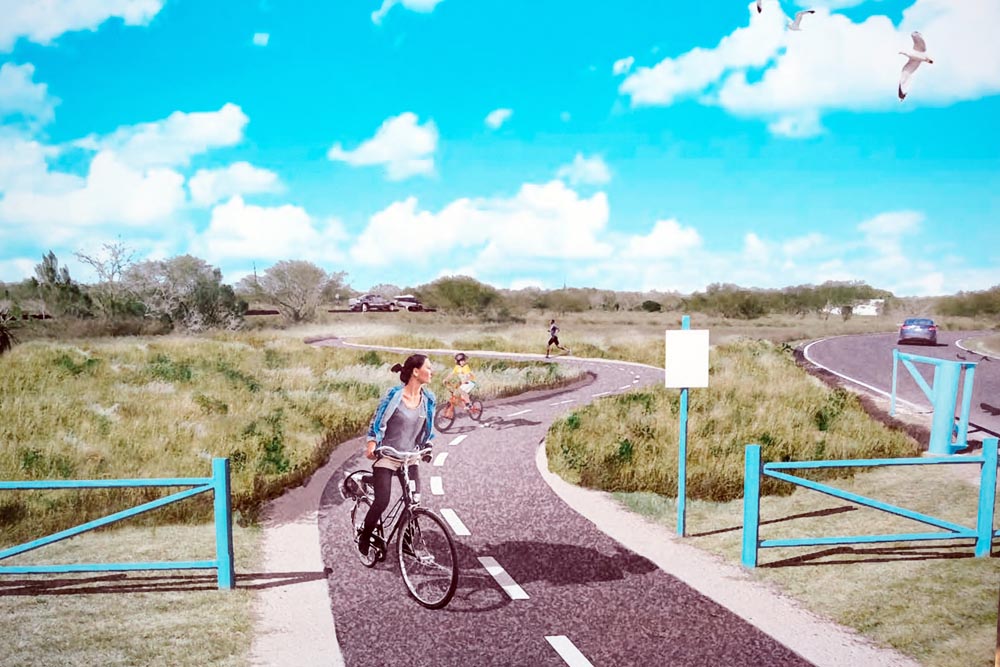Thirteen years after a grass-roots group of West Brownsville residents assembled themselves to oppose a proposed toll road along what would become former Union Pacific railroad right of way, on Friday a ceremonial groundbreaking was held to mark their victory.
Elected officials representing Cameron County and the city of Brownsville joined a number of other stakeholders where the railroad tracks once crossed U.S. 281/Military Road to celebrate the start of construction of the West Rail Trail, which that grass-roots group — Friends of the West Rail Trail — has long lobbied for.
Each speaker who took the podium stressed that the hike-and-bike trail project wouldn’t have been possible without a lot of people working together, including essential cooperation between the city and the county, which donated the nearly eight miles of right-of-way to the city after Union Pacific relocated its route west of town and deeded the land to the county.
Cameron County Judge Eddie Trevino Jr. said there were far too many people involved to name but singled out Larry Hollmann, a member of Friends since the beginning, and Brownsville City Commissioner Rose Gowen, an outspoken advocate for the West Rail Trail as well and Caracara Trails, the countywide trail system under development of which West Rail Trail is a part.
“When people get behind something, when people decide to work together for the betterment of their community, to enhance their community, and to see that dream become a reality … it is a beautiful, beautiful thing,” Trevino said.
He noted that the trail project was spawned by the West Rail Relocation Project to move the Union Pacific route out of town and eliminate 14 at-grade rail crossings that tied up traffic in West Brownsville for decades. The relocation project began during Trevino’s tenure as mayor in the early 2000s, when Gilberto Hinojosa, now chairman of the Texas Democratic Party, served as county judge.
That effort finally culminated in the first international rail bridge to be built between the United States and Mexico in more than 100 years. The new West Rail bridge was dedicated in August 2015, with Obama administration officials in attendance.
Trevino also singled out County Commissioner Joey Lopez, the Cameron County Regional Mobility Authority and CCRMA Director Pete Sepulveda Jr. for their key roles in bringing the trail project to fruition. The Texas Department of Transportation on Oct. 1 gave the city permission to proceed with construction, and on Oct. 14 the city announced that the Rio Grande Valley Metropolitan Planning Authority had pledged $900,000 for benches, shade structures and other amenities along the trail.
The city has committed $8 million to build the trail itself, money that became available after the city was reimbursed for a number of pandemic-related expenditures through the American Rescue Plan, which categorizes those funds discretionary. The current plan is to build 6.6 miles of trail from just north of the 77 Flea Market at I-69E to near Palm Boulevard in Brownsville. The aim is to eventually connect it to the former rail Union Pacific on the Mexican side of the border.
Gowen said the trail is a big deal economically and in terms of quality-of-life, while also giving residents another opportunity to lead more active lives — important in a city and region with epidemic levels of obesity, diabetes and related illnesses. If construction goes according to schedule, a ribbon cutting can be expected in 220 days, she said. Gowen thanked Trevino and Lopez for working with the city and said “the city and the county are the strongest that we can be. I think this project proves that.”
She also gave kudos to Friends, noting that if the group’s members hadn’t taken the time going door to door to collect 5,000 signatures to present to the city commission in support of a trail and against a road all those years ago, “then we wouldn’t be here.” Gowen proposed that signs along the trail recognize the group’s effort.
“In many ways this is the Friends’ trail,” she said.
Hollmann, speaking for the group, said that the West Rail Trail project coming to fruition is a win for everyone and a loss for no one.
“Are we really here? Thirteen years ago I wouldn’t have bet on this,” he said. “It’s been a good struggle. … I’m kind of pinching myself to believe that it’s really happening.”
Brownsville Mayor Trey Mendez described the success of the trail project as “a testament to the neighborhood and a testament to the power of organization and to staying resilient and strong.”
“These are all qualities that epitomize our city as well,” he said.









